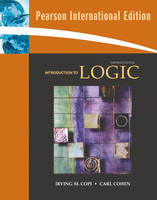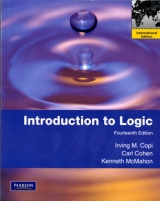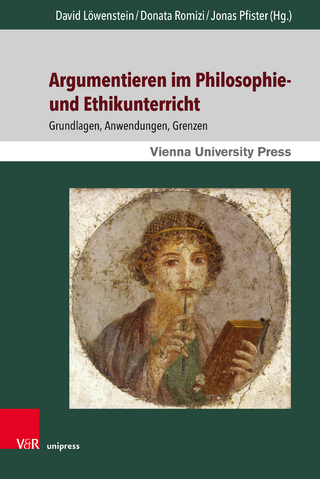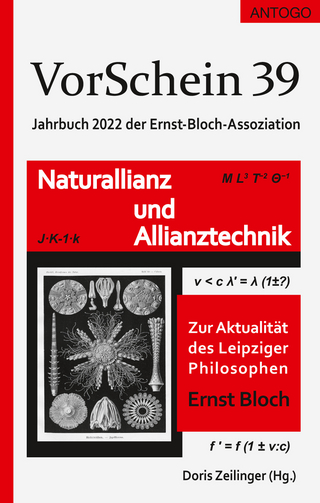
Introduction to Logic
Pearson (Verlag)
978-0-13-136419-6 (ISBN)
- Titel erscheint in neuer Auflage
- Artikel merken
Copi's Introduction to Logic introduces students to the fundamental methods and techniques of correct reasoning, in a manner that shows the relevance of the topics to their everyday lives.
This book introduces the fundamental methods and techniques of correct reasoning, in a manner that shows the relevance of the topics to readers everyday lives. Many new exercises introduced in this edition help supplement and support explanations, aid in review, and make the book visually stimulating. KEY TOPICS: Includes many fascinating illustrations taken from the history of science as well as from contemporary research in the physical and biological sciences, plus introduces an abundance of new exercises throughout, complete with solutions for the first exercise in a set. MARKET: Appropriate for those in business, education, political, or psychology careers.
PART I LOGIC AND LANGUAGE
SECTION A REASONING
CHAPTER 1 Basic Logical Concepts
1.1 What Logic Is
1.2 Propositions and Arguments
1.3 Recognizing Arguments
1.4 Arguments and Explanations
1.5 Deductive and Inductive Arguments
1.6 Validity and Truth
CHAPTER 2 Analyzing Arguments
2.1 Paraphrasing Arguments
2.2 Diagramming Arguments
2.3 Complex Argumentative Passages
2.4 Problems in Reasoning
SECTION B INFORMAL LOGIC
CHAPTER 3 Language and Definitions
3.1 Language Functions
3.2 Emotive Language, Neutral Language, and Disputes
3.3 Disputes and Ambiguity
3.4 Definitions and Their Uses
3.5 The Structure of Definitions: Extension and Intension
3.6 Definition by Genus and Difference
CHAPTER 4 Fallacies
4.1 What Is a Fallacy?
4.2 Classification of Fallacies
4.3 Fallacies of Relevance
4.4 Fallacies of Defective Induction
4.5 Fallacies of Presumption
4.6 Fallacies of Ambiguity
PART II DEDUCTION
SECTION A CLASSICAL LOGIC
CHAPTER 5 Categorical Propositions
5.1 The Theory of Deduction
5.2 Classes and Categorical Propositions
5.3 The Four Kinds of Categorical Propositions
5.4 Quality, Quantity, and Distributions
5.5 The Traditional Square of Opposition
5.6 Further Immediate Inferences
5.7 Existential Import and the Interpretation of Categorical Propositions
5.8 Symbolism and Diagrams for Categorical Propositions
CHAPTER 6 Categorical Syllogisms
6.1 Standard-Form Categorical Syllogisms
6.2 The Formal Nature of Syllogistic Argument
6.3 Venn Diagram Technique for Testing Syllogisms
6.4 Syllogistic Rules and Syllogistic Fallacies
6.5 Exposition of the Fifteen Valid Forms of the Categorical Syllogism
Appendix: Deduction of the Fifteen Valid Forms of the Categorical Syllogism
CHAPTER 7 Syllogisms in Ordinary Language
7.1 Syllogistic Arguments
7.2 Reducing the Number of Terms to Three
7.3 Translating Categorical Propositions into Standard Form
7.4 Uniform Translation
7.5 Enthymemes
7.6 Sorites
7.7 Disjunctive and Hypothetical Syllogisms
7.8 The Dilemma
SECTION B MODERN LOGIC
CHAPTER 8 Symbolic Logic
8.1 Modern Logic and Its Symbolic Language
8.2 The Symbols for Conjunction, Negation, and Disjunction
8.3 Conditional Statements and Material Implication
8.4 Argument Forms and Refutation by Logical Analogy
8.5 The Precise Meaning of “Invalid” and “Valid”
8.6 Testing Argument Validity Using Truth Tables
8.7 Some Common Argument Forms
8.8 Statement Forms and Material Equivalence
8.9 Logical Equivalence
8.10 The Three “Laws of Thought”
CHAPTER 9 Methods of Deduction
9.1 Formal Proof of Validity
9.2 The Elementary Valid Argument Forms
9.3 Formal Proofs of Validity Exhibited
9.4 Constructing Formal Proofs of Validity
9.5 Constructing More Extended Formal Proofs
9.6 Expanding the Rules of Inference: Replacement Rules
9.7 The System of Natural Deduction
9.8 Constructing Formal Proofs Using the Nineteen Rules of Inference
9.9 Proof of Invalidity
9.10 Inconsistency
9.11 Indirect Proof of Validity
9.12 Shorter Truth-Table Technique
CHAPTER 10 Quantification Theory
10.1 The Need for Quantification
10.2 Singular Propositions
10.3 Universal and Existential Quantifiers
10.4 Traditional Subject–Predicate Propositions
10.5 Proving Validity
10.6 Proving Invalidity
10.7 Asyllogistic Inference
PART III INDUCTION
SECTION A ANALOGY AND CAUSATION
CHAPTER 11 Analogical Reasoning
11.1 Induction and Deduction Revisited
11.2 Argument by Analogy
11.3 Appraising Analogical Arguments
11.4 Refutation by Logical Analogy
CHAPTER 12 Causal Reasoning
12.1 Cause and Effect
12.2 Causal Laws and the Uniformity of Nature
12.3 Induction by Simple Enumeration
12.4 Methods of Causal Analysis
12.5 Limitations of Inductive Techniques
SECTION B SCIENCE AND PROBABILITY
CHAPTER 13 Science and Hypothesis
13.1 Scientific Explanation
13.2 Scientific Inquiry: Hypothesis and Confirmation
13.3 Evaluating Scientific Explanations
13.4 Classification as Hypothesis
CHAPTER 14 Probability
14.1 Alternative Conceptions of Probability
14.2 The Probability Calculus
14.3 Probability in Everyday Life
| Erscheint lt. Verlag | 12.1.2009 |
|---|---|
| Sprache | englisch |
| Maße | 225 x 186 mm |
| Gewicht | 1066 g |
| Themenwelt | Geisteswissenschaften ► Philosophie ► Logik |
| ISBN-10 | 0-13-136419-7 / 0131364197 |
| ISBN-13 | 978-0-13-136419-6 / 9780131364196 |
| Zustand | Neuware |
| Haben Sie eine Frage zum Produkt? |
aus dem Bereich



